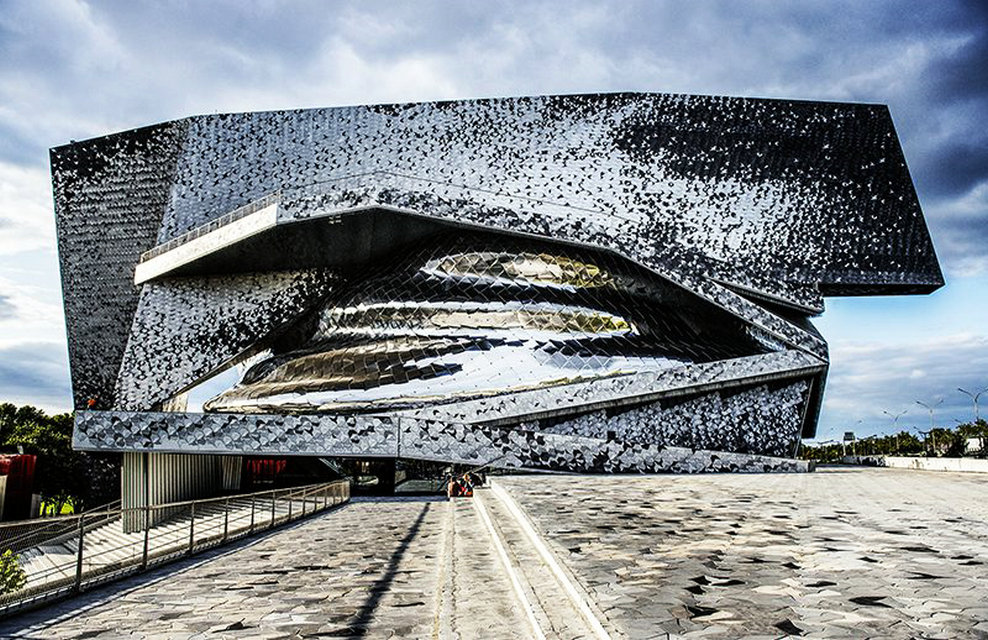Philharmonie de Paris, France


The Philharmonie de Paris is a cultural institution in Paris, France which combine spaces all dedicated to music. It is composed of concert halls, exhibition spaces, rehearsal rooms, educational services, restaurant and bars. The main buildings are all located in the Parc de la Villette at the northeastern edge of Paris in the 19th arrondissement. At the core of this set of spaces is the symphonic concert hall of 2,400 seats designed by Jean Nouvel and opened in January 2015. Its construction had been postponed for about twenty years to complete the current musical institution la Cité de la Musique designed by Christian de Portzamparc and opened since 1995. Mainly dedicated to symphonic concerts, the Philharmonie de Paris also present other forms of music such as jazz and world music.
The Philharmonie de Paris is a cultural institution in Paris, France which combine spaces all dedicated to music. It is composed of concert halls, exhibition spaces, rehearsal rooms, educational services, restaurant and bars. The main buildings are all located in the Parc de la Villette at the northeastern edge of Paris in the 19th arrondissement. At the core of this set of spaces is the symphonic concert hall of 2,400 seats designed by Jean Nouvel and opened in January 2015. Its construction had been postponed for about twenty years to complete the current musical institution la Cité de la Musique designed by Christian de Portzamparc and opened since 1995. Mainly dedicated to symphonic concerts, the Philharmonie de Paris also present other forms of music such as jazz and world music.
The new institution dedicated to all music concerts, exhibitions, museum, musical practice.The Philharmonie de Paris is a cultural institution mainly devoted to symphonic music, benefiting from high-quality acoustic equipment, as well as chamber music, jazz and world music. It includes the “Philharmonie 1”, inaugurated on January 14, 2015, consisting of a 2,400-seat concert hall, called “Grande Salle”, exhibition spaces, educational workshops and rehearsal rooms, and Cité de la musique, opened in 1995 and renamed “Philharmonie 2”, consisting of two other 900 and 250 seat concert halls, the Music Museum and a media library. Its resident ensembles are the Orchester de Paris and the Ensemble intercontemporain.
Jean Nouvel was surrounded by Brigitte Métra as an associate architect for the concert hall, acousticians Marshall Day Acoustics (acoustic design of the room), Nagata Acoustics (architect’s consulting and model tests) 4 and Studio DAP for the Acoustics of the building. Les Ateliers Jean Nouvel were surrounded by Jacques Le Marquet and ducks scenography for the scenography of the room. The project is part of the architectural space of the Parc de la Villette, designed by architect Bernard Tschumi, including the Cité de la musique designed by Christian de Portzamparc, the Grande Halle de la Villette, the Cité des sciences et de l Industry and Geode. The design of the project takes the forms of an aluminum hill covered with horizontally stacked paving stones cut from a vertical aileron to play on existing perspective lines. It stands like a hill offering a panorama of Paris and its surroundings, beyond the ring road.
In addition to a 2,400-seat concert hall, the venue includes an exhibition space of more than 1,100 m2, a 1,750 m2 educational center, orchestra halls, rehearsal rooms, Studios and a restaurant. The high visibility allows a simplified operation of the rental and a single price on all the places. This rate is declined according to the proposed show. The Philharmonie de Paris also offers many places at a reduced price.
The auditorium is mainly devoted to symphonic music, with acoustic excellence being sought in the first place. It also hosts music repertoires with more reverberated acoustics. Acoustically, the concert hall differs from the strictly frontal models in the form of a “shoe box” and favors an envelopment of the stage by the public on the model of the Philharmonie of Berlin in order to reinforce the feeling of intimacy between The interpreter and his audience.
With this enveloping structure, the distance between the conductor and the farthest listener is maximum 32 meters. To ensure good acoustic performance, the total volume of the room does not exceed 30 000 m3. It allows the development of a late sound field and an appropriate reverberation for symphonic concerts. Since the Paris Philharmonic is not limited to classical ensembles, it is planned to equip the theater for modular acoustic and technical scenography.
The symphonic organ of the Philharmonic, built by Rieger Orgelbau, is inaugurated on 6 February 2016. It consists of 6,055 pipes and is made of 25 tons of wood and metal. The organist of the Philharmonic has 91 plays, as many possible sounds (flute, violin, trumpet …). Each game is composed of 61 notes, thus 61 pipes. The biggest, which corresponds to the serious fa of the double bass, measures 7.23 meters and weighs more than 350 kg. The smallest, 7.5 millimeters and a few tens of grams, gives the acute fa of the piccolo. “